Here’s a story about a dermatologist who had a hair transplant when he was 25 years old, in 1975. Forgive the blurriness of the photo below.
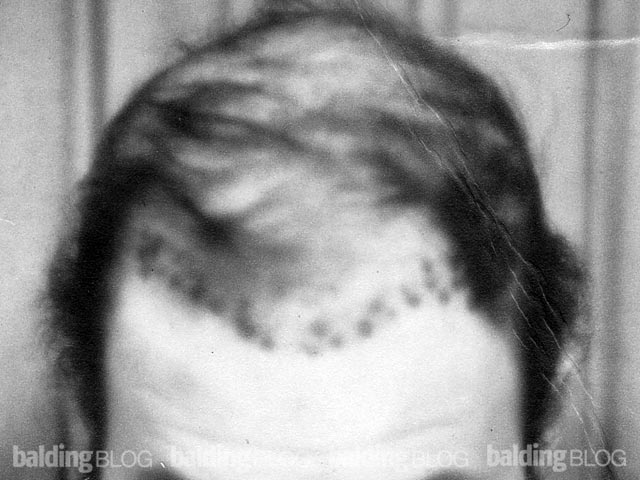
What is particularly important about this first picture is the amount of hair that he actually had when the transplant process was started. He was clearly thinning his hair in the Norwood Class 6 balding pattern and if he were treated today, he would have been put on finasteride (Propecia) to halt the hair loss and hopefully lock in the Norwood Class 6 pattern. When he had the plugs put in, the hair was still there, although clearly heavily miniaturized. The photo above was taken in the first month after the surgery and the hideous looking islands reflected grafts that contained between 20-30 hairs and crusting after the surgery. The crusts which are shown here are only a few weeks old, but in those days, the patients were deformed for months after the surgery as the healing progressed very slowly. The only good news for this man was that many of the hairs failed to grow, reducing the pluggy appearance, simply because of the failure of hairs to grow. His first procedure put two lines of plugs in the frontal hairline, which were followed up with many more plugs at another surgical session.
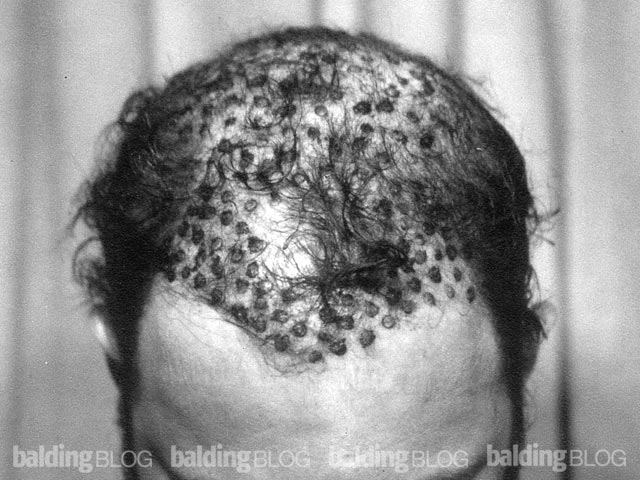
 He eventually lost all of his hair native in the Norwood Class 6 pattern. The grafts were taken out of his donor area with hollow drills measuring slightly under 1/4 inch which left him with white spots about 1/4 inch round that could easily be seen through the thinned out donor area. After he completed his surgery, he developed a comb-over to hide the plugs, but the hairline was still deforming and even with a comb-forward style, he could not hide the hideous grafts.
He eventually lost all of his hair native in the Norwood Class 6 pattern. The grafts were taken out of his donor area with hollow drills measuring slightly under 1/4 inch which left him with white spots about 1/4 inch round that could easily be seen through the thinned out donor area. After he completed his surgery, he developed a comb-over to hide the plugs, but the hairline was still deforming and even with a comb-forward style, he could not hide the hideous grafts.
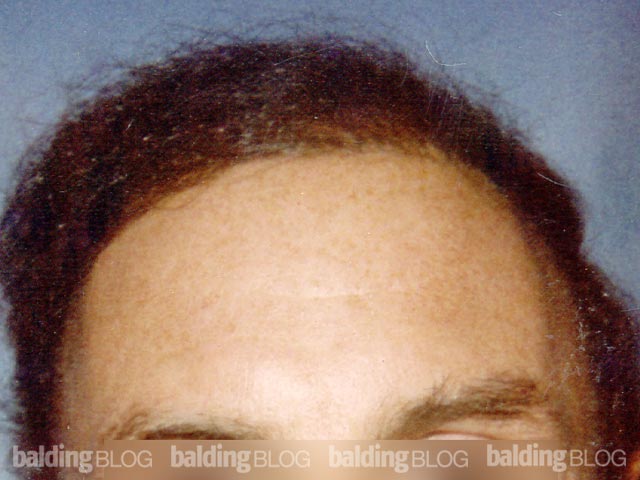
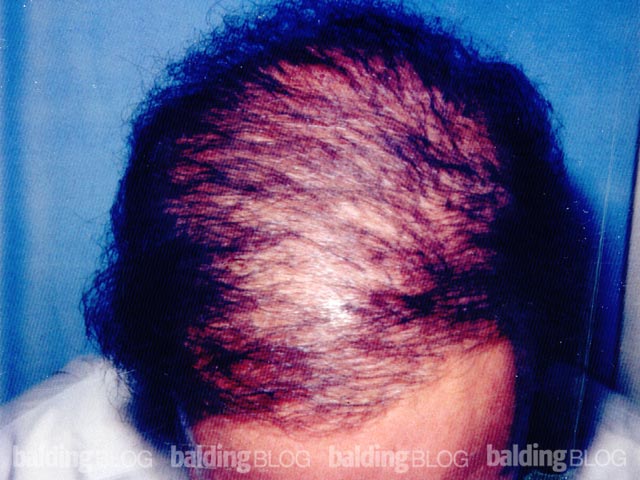
In 1988, he went to Denver and had a few hundred micrografts placed in front of the hairline by the inventor of the micrograft. The focus was to put camouflage in front of the plugs. This surgery did much to soften his look. Still, on meeting people in his dermatology practice, eyes focused on his hairline and the top of his head. That convinced him that he needed to find a better solution. Eventually, he had grafts removed, received dermabrasion to smooth out the bumps and cobblestoning, and had about 8 laser hair removal procedures to kill off the hair that he worked so hard to put there. To deal with the deformities created by the harvesting techniques, he had finely stippled tattoos created to look like hair and this hides most of the scars on the side and back of his head. His final look, one of a bald man, seems to work for him. His approach to his problem was creative and it showed me the value of the old saying: “Necessity is the mother of invention”. This doctor, armed with a unique set of skills (dermatologist) and facing his deformities every day in the mirror, applied his talents to solve his problem. He got there and now people who see him as a doctor, look straight into his eyes, not at his head. Congratulations!
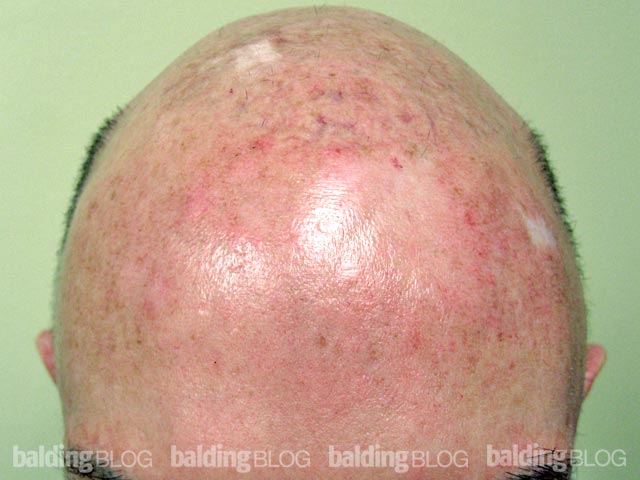
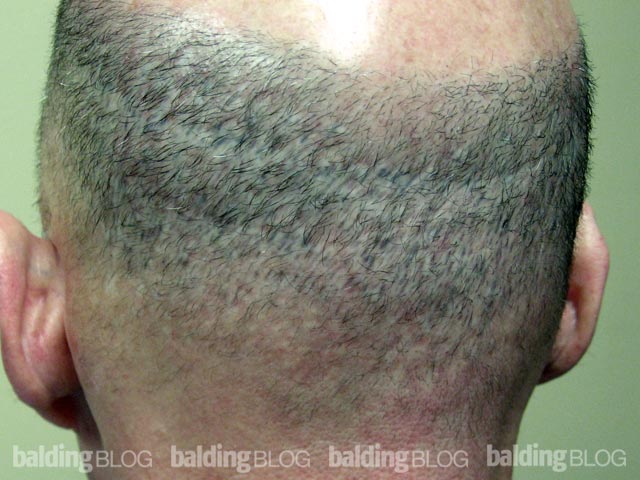
Note: Most people see someone just like this man walking down the street, at a movie, in a restaurant, or at an airport. There is a perception that this pluggy look is the look of a hair transplant, but this type of procedure, if done today, would be clear malpractice and not acceptable in this litigious legal climate. Unfortunately, tens of thousands of men had this awful surgery done worldwide years ago. The victims were many — far too many. Personally, I can not imagine why a doctor would ever perform such a surgery. Fortunately, there are many ways to treat this problem and becoming bald is just one option (see Repair – Dean’s Story for an example of using hair transplantation to correct the old plugs).
For even more information on repair, please see:

 Stress contributes to hair loss in those genetically impacted. Finasteride (Propecia) works to block the hair loss and prevent it from happening in most men. Anything that reduces stress is also a good idea, so if counseling work for you, then go for it. The fear of hair transplantation is something that reflects general ignorance. My job is not to convert you or get you to reverse your opinion as to what line you will not cross, but my two hair transplants were the most non-events of my life (in regards to the actual procedure). Most of my patients tell me the same thing, and the benefits certainly deal with the stress directly. One of my patients is a psychologist who had 18 years of psychoanalysis to help him deal with his hair loss. The first of two transplant procedures yielded wonderful results. He said to me that he wasted his money for 18 years, when in one day he solved his problem and the stress went away as the hair grew in.
Stress contributes to hair loss in those genetically impacted. Finasteride (Propecia) works to block the hair loss and prevent it from happening in most men. Anything that reduces stress is also a good idea, so if counseling work for you, then go for it. The fear of hair transplantation is something that reflects general ignorance. My job is not to convert you or get you to reverse your opinion as to what line you will not cross, but my two hair transplants were the most non-events of my life (in regards to the actual procedure). Most of my patients tell me the same thing, and the benefits certainly deal with the stress directly. One of my patients is a psychologist who had 18 years of psychoanalysis to help him deal with his hair loss. The first of two transplant procedures yielded wonderful results. He said to me that he wasted his money for 18 years, when in one day he solved his problem and the stress went away as the hair grew in.



 He eventually lost all of his hair native in the Norwood Class 6 pattern. The grafts were taken out of his donor area with hollow drills measuring slightly under 1/4 inch which left him with white spots about 1/4 inch round that could easily be seen through the thinned out donor area. After he completed his surgery, he developed a comb-over to hide the plugs, but the hairline was still deforming and even with a comb-forward style, he could not hide the hideous grafts.
He eventually lost all of his hair native in the Norwood Class 6 pattern. The grafts were taken out of his donor area with hollow drills measuring slightly under 1/4 inch which left him with white spots about 1/4 inch round that could easily be seen through the thinned out donor area. After he completed his surgery, he developed a comb-over to hide the plugs, but the hairline was still deforming and even with a comb-forward style, he could not hide the hideous grafts.


